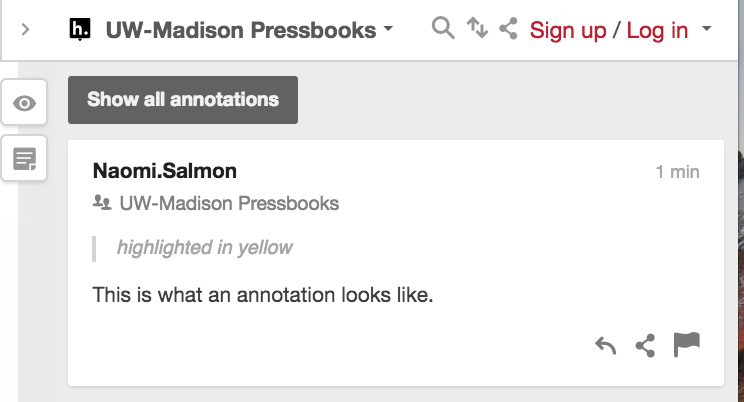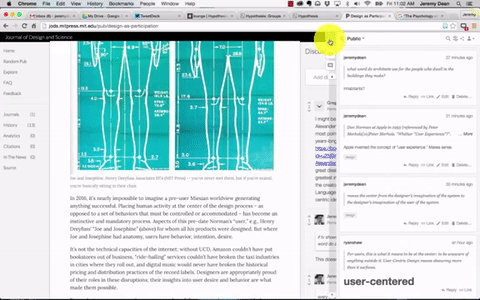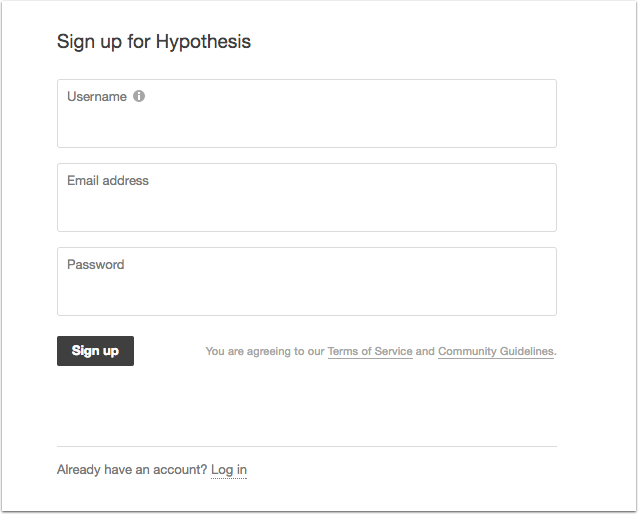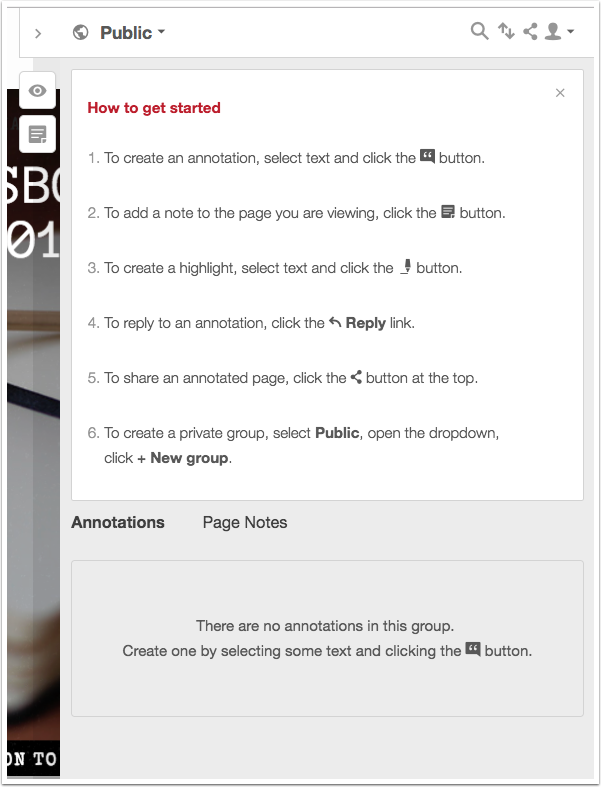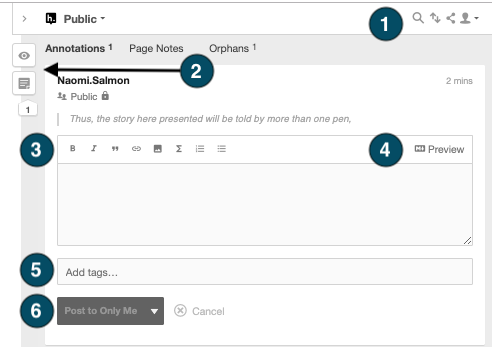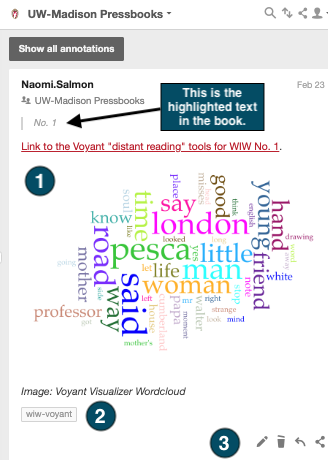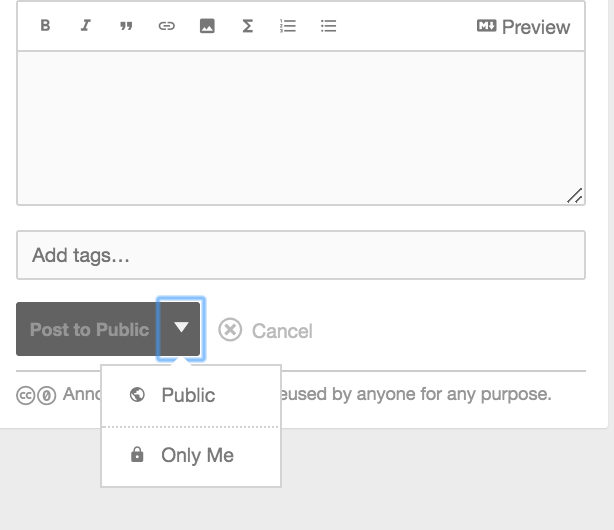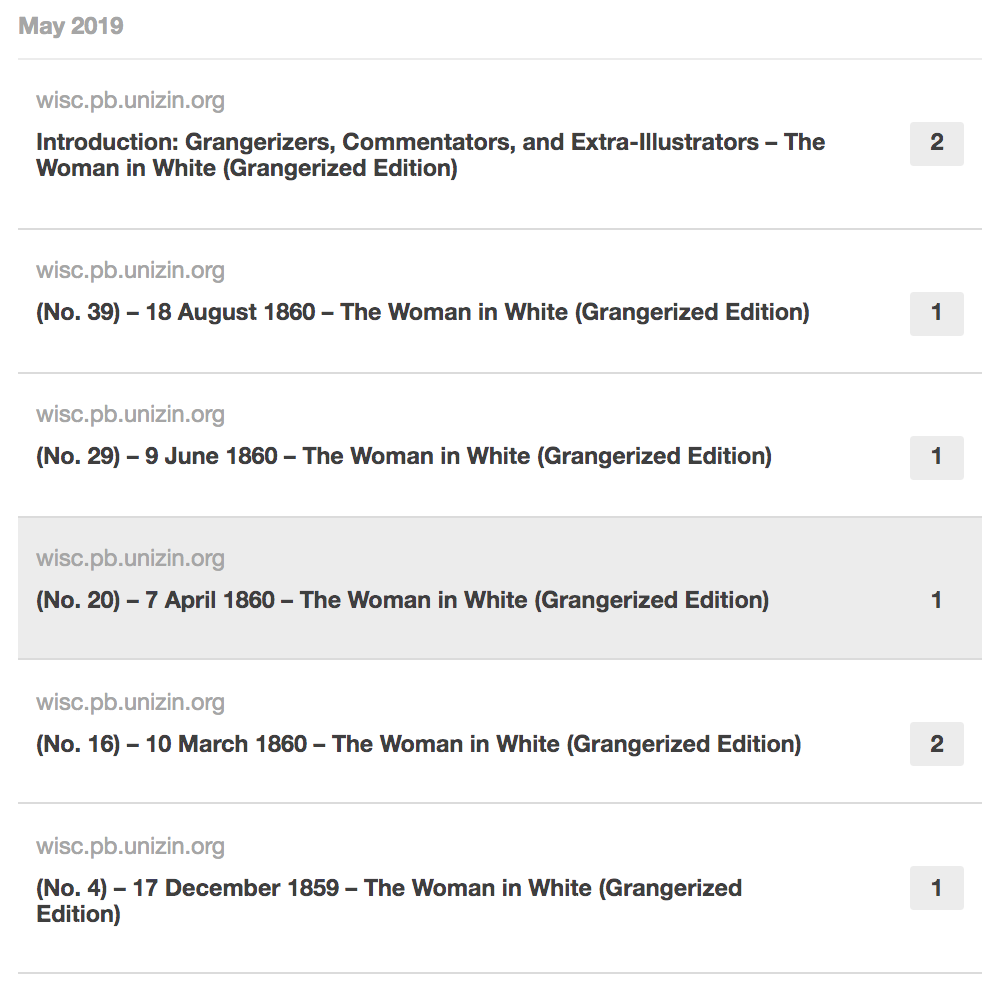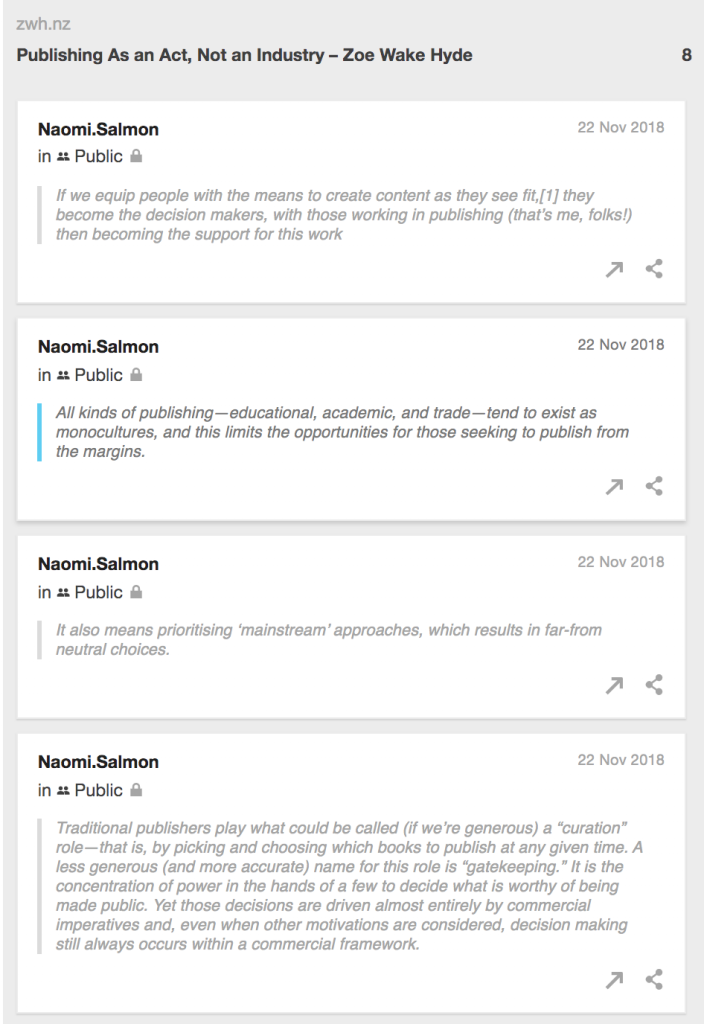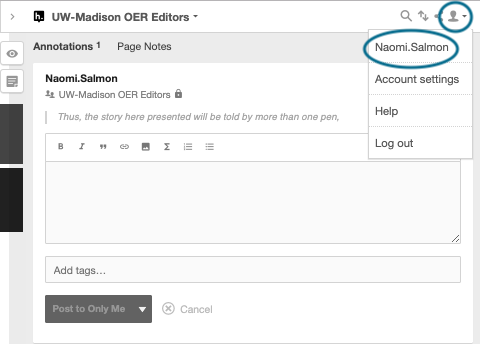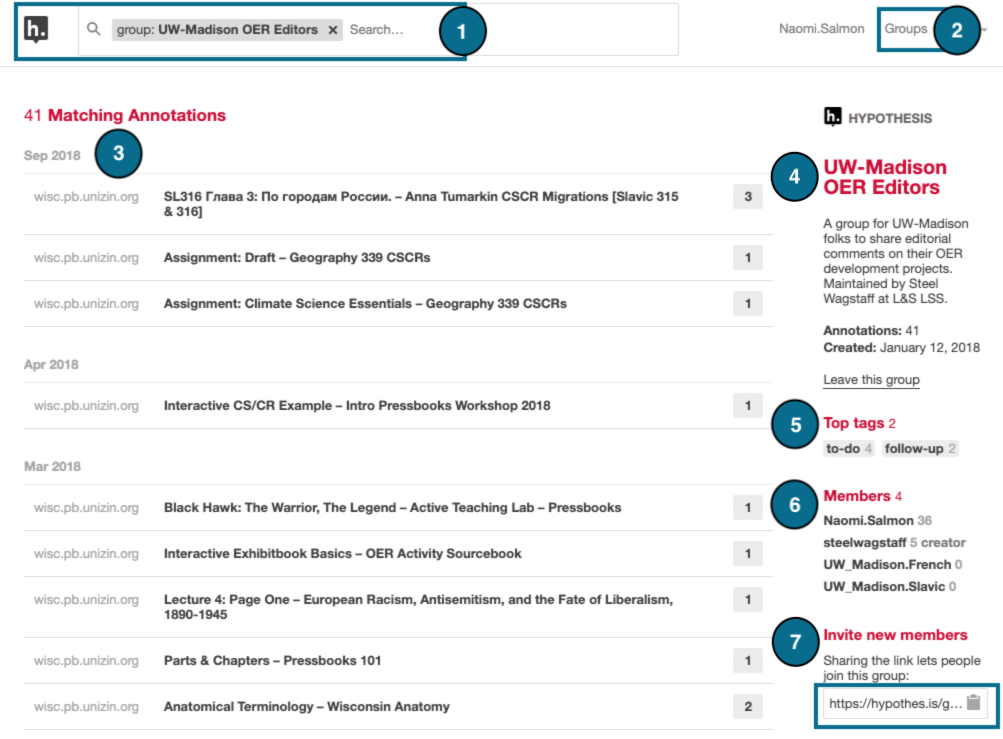Participant Resources
The Annotation Layer: A How-To Guide
The Basics
The annotations that accompany the web version of this text appear highlighted in yellow.
For example, this note should appear highlighted in yellow. Try clicking on it!
Doing so should expand an annotation toolbar on the right-hand side of your screen. (You may need to wait a few seconds for this to render.)
Once the annotation toolbar is expanded, clicking outside of the toolbar–for instance, in the space on the left-hand side of your screen–should hide the annotation toolbar once more.
If you find the yellow annotation highlights distracting, you can also click on the eye icon at the top right-hand side of your screen to hide them from view.
When you click on a highlight and the sidebar opens, you’ll see the words “UW-Madison Pressbooks” appear at the top of the pane.
You can display all of the annotations on this layer at once by clicking the “show all annotations at once” button that appears when you’ve expanded a single annotation highlight. Another approach: when the annotation pane is closed, you can display all of a page’s annotations by clicking the carat symbol at the top-right-hand side of the screen: (“<“). Clicking on the carat again (“>”) will hide the annotation pane.
You can change the width of this annotation pane by clicking and dragging the sidebar:
Once the annotation toolbar is expanded, clicking outside of the toolbar–for instance, in the space on the left-hand side of your screen–should hide the annotation toolbar once more.
Public Annotation Layers
This text contains two different public Hypothes.is annotation layers. The first is the published UW-Madison Pressbooks publisher layer, which is what you should see by default on this and many other pages in this project.
I use this layer to post supplemental material that may be primarily of use to readers accessing the web version of the text.
The Public annotation layer is a space where you can contribute thoughts of your own. It’s also a space where you can take part in some of the guided engagement activities in this text.
Joining In
You don’t need to be registered to view the UW-Madison annotation publisher layer, but to add your own comments to the layer, but to view or contribute comments on the public discussion sidebar, you’ll need to register for a Hypothes.is account. To do so, you’ll need to provide a username, email address, and password and then click the Sign-Up button. After that, you should receive a confirmation email with a link to click to validate your account. If you don’t see this email, check your Spam or Junk folder.
Toggle Between Layers to View The Public Annotation Space
Adding Annotations
The How to Get Started box is displayed the first time you log into your Hypothes.is account. It offers explanations of the different button functions and briefly outlines how to use them.
To create an annotation or highlight, start by selecting the text and then choose either annotate or highlight. Choosing annotation will open the annotation pane to a new blank annotation field. Selecting highlight will highlight the text you have selected.
Annotation Pane Tour
- Filter, Sort, Share, and Account buttons
- Turn on/off highlights, create annotation buttons
- Text editor formatting tools – bold, italic, quotation, link, media, LaTex, numbered list, bulleted list,
- Preview annotation
- Tags Field – add multiple tags separated by commas
- Post button – you can use the drop-down button to easily switch between Public, Private, and Group posting
Once you’ve created an annotation, it will appear in the annotation pane on the right side of the page. It features the text that you’ve selected to annotate at the top, your annotation text, and any tags you have added.
In the screenshot below, you’ll see an annotation (1). In this case, I’ve provided a word cloud image of the most common words in a chapter to provide readers with a playful way of reading the novel ‘from a distance.’ Item (2) illustrates what tags look like when you use them on an annotation, and item (3) displays the edit, delete, reply, and share buttons.
Taking Private Reading Notes
Hypothesis allows you to publish notes publicly or privately. When you’re on the “Public Layer,” clicking on the down arrow nested inside the “Post to Public” button allows you to decide whether your annotation in this public layer will be visible to other readers or to only you. (You’ll see a padlock icon appear next to annotations you’ve marked private.)
The ability to highlight and archive passages in this way can be especially helpful if you’re planning to write a paper or journal article about this novel. If you’re logged into Hypothesis, either clicking on your name in the annotation bar or navigating to the page https://hypothes.is/users/YOURUSERNAME (with your username in place of the allcaps section) will show you an aggregated list of all of your public and private annotations.
Clicking on the webpage titles in this section will display your highlighted passages or notes in more detail. Here’s an example of a collected list of private annotations on an online article:
If you’ve been using the tag function to label your annotations by theme, you can look back at themed groups of annotations using annotation search filters on the Hypothesis page.
A Different Approach:
Creating a Private Group
If you would like to have a private discussion space that is only accessible to people you invite—for instance, students in your class or peers in a study group—I recommend following the Hypothes.is Creating a Group step-by-step guide video tutorial.
Joining a Group
The following Hypothes.is “Joining a Group” step-by-step guide video tutorial provides a comprehensive overview:
Review a Group’s Annotations
Once you’re a member of a group, you can easily review the annotations that the members of that group have created.
To navigate to the annotation activity for a specific group, open the annotation pane on your book and select the user icon to open the drop-down tray of options, then click on your username.
This will load your account page, from there click Groups and from the drop-down tray select the group you want to review.
This will load the group page that you’ve selected. At the top of the page you’ll find (1) the group you’ve selected as a filter in the search box, (2) the account and group navigation options in the top right of the page, (3) a listing of the matching annotations for the group tag, (4) the name of the group and group information, (5) a listing of the top tags for the group, (6) a list of members in the group, and (7) the link to invite new members to the group.
Resources
Hypothes.is offers some great resources for using annotations with students and in groups. Check out the following resources:
Back to School with Annotation: 10 Ways to Annotate with Students – offers 10 creative ways to use annotation with your students.
Annotation Tips for Students – offers tips aimed towards helping students complete annotations.
How to Embed Images and Other Media Into an Annotation
Hypothes.is Education – offers more guides and classroom examples for using Hypothes.is.
You can also check out the Hypothes.is YouTube channel tutorials.
Source
The Hypothes.is tutorial on this page is adapted from UW-Madison’s Pressbooks 101 text, which was originally created by Steel Wagstaff and Amanda Larson and maintained by Naomi Salmon (2018). Pressbooks 101 is openly shared under a Creative Commons Attribution 2.0 license.


